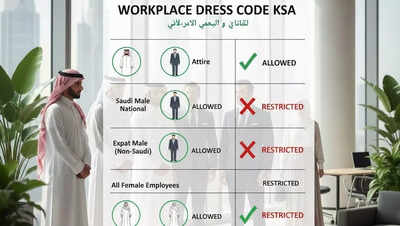Saudi Arabia’s Ministry of Human Resources and Social Development (HRSD) has put forward a draft Code of Appearance and Conduct for public and private-sector staff. The rules say Saudi men should wear the national dress (thawb and ghutra/shemagh), non-Saudi employees should wear a formal suit, and female staff must dress modestly, not tight or transparent. The draft is currently out for public consultation.Saudi Arabia’s new corporate dress ruleThe Kingdom of Saudi Arabia is formalizing its professional environment by introducing a stringent new “Code of Appearance and Conduct” that applies to every employee nationwide. Spearheaded by the Ministry of Human Resources and Social Development (MHRSD), this regulation aims to standardize workplace decorum, promote national identity, and ensure a unified professional image across all economic sectors.This mandate moves beyond merely suggesting attire; it lays down explicit requirements for both Saudi nationals and expatriate workers across the public, private, and non-profit sectors. The core of the new rule is the distinction between Saudi men and non-Saudi men, ensuring the national identity is visibly honored in the workplace.
- For Saudi Male Employees: The rules strictly mandate the wearing of the Official National Dress. This typically means the long white robe (Thobe) paired with the headdress, either the Ghutra or the Shemagh. This directive reinforces the Kingdom’s heritage and pride within the professional sphere.
- For Non-Saudi Male Employees (Expats): Non-Saudi men are now required to wear the Formal Suit (البدلة الرسمية). This eliminates ambiguity around business casual wear and enforces a high standard of formality for all foreign staff interacting in professional capacities.
Rules for Saudi female employees
The new guidelines establish clear standards for female employees across all sectors, focusing on modesty and professionalism.
- For All Female Employees (Saudi and Non-Saudi): Women are required to wear modest clothing that completely covers the body.
- Clarity on Attire: The clothing must explicitly be neither tight nor transparent.
- Application: This requirement applies not just to daily office work, but also during any participation in official functions or media appearances related to their job. The goal is to ensure decency and uphold public morals and professional standards in all professional settings.
Conduct, and penalties
The new “Code of Appearance and Conduct” covers more than just garments; it sets the tone for the entire professional environment and includes consequences for non-compliance. The regulation also addresses general professional conduct, requiring adherence to good behavior, maintaining personal hygiene, and ensuring a dignified professional appearance.Employees must refrain from wearing items or accessories that carry political, ideological, or otherwise offensive slogans, symbols, or images.The Ministry places a strong emphasis on the role of the employer. All private companies are now required to draft and post a clear, written internal dress code based on these regulations. Failure by a company to establish or enforce these standards makes them liable for fines under the Saudi Labor Law. Penalties for violating labor regulations (including dress code enforcement) have historically ranged up to SR 5,000 for the establishment.
Final thought
Saudi Arabia’s draft dress code signals a clearer, more standardised approach to workplace appearance across public and private sectors. While it reinforces national identity and sets consistent expectations for employees, it also introduces practical changes that organisations and workers will need to understand and adapt to. As the consultation period continues, the final version of the rules will depend on public feedback, but the direction is clear: the Kingdom is moving toward a more defined and unified professional image. For now, employers and employees alike are watching closely to see how the guidelines evolve and what they will mean for everyday office life.




